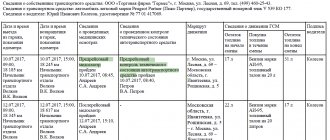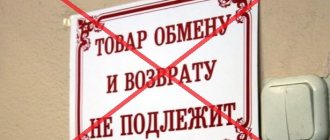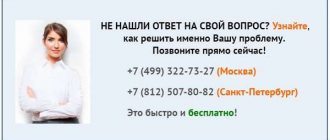What is this
This is the name given to a rectangular piece of paper that reflects the most important text about the product that the buyer plans to purchase. He needs to quickly find data on the cost of the item he likes, its promotional status and other important parameters.
This is necessary to make a purchasing decision; without such a label, a person may refuse to purchase or choose another product that will have comprehensive data underneath it.
There is a special system of rules, formats and sizes of the standard price tag, which every seller is obliged to follow. This is designed not to mislead the customer regarding the properties, characteristics and price of the products sold.
They are quite easy to break, so it is worth studying them in advance. If you print sheets of different shades, Rospotrebnadzor will consider this a violation. This can only be avoided by familiarizing yourself with the articles and clauses of the laws. We propose to consider all the nuances in detail.
What laws govern pricing?
The main legal guarantors of the buyer’s interests and defenders from unscrupulous sellers are the Federal Law “On the Protection of Buyer’s Rights” and the Civil Code of the Russian Federation.
Civil Code of the Russian Federation
Articles 426 and 492 of the Civil Code of the Russian Federation classify the retail sale of consumer goods as public contracts - agreements with an indefinite number of persons. According to the same code, any public organization that sells goods and offers services to the public must:
- establish a uniform price for all buyers/consumers (except for those who are legally entitled to benefits);
- conclude an agreement with everyone who wishes;
- When drawing up contracts, do not give any preference to anyone.
Important: the display of goods at a certain price in the sales area, on display cases, racks and other places of sale is nothing more than a public offer - that is, an offer to a potential buyer to conclude an agreement. Except for the cases specified in Article 494 of the Civil Code of the Russian Federation, when the seller clearly indicates that a particular product is not for sale.
The law obliges any seller to provide reliable information regarding the item of trade (product). And if the information the buyer needs is not communicated, the seller is obliged to compensate for losses incurred in connection with this (Article 495 of the Civil Code of the Russian Federation). That is, at a minimum, return the cost of the goods if the contract has already been concluded (and the stamped cash receipt indicates exactly this).
Law on Consumer Protection"
The seller must also provide reliable information about the goods being sold according to the Law “On the Protection of Consumer Rights” (Article 10). There is a whole information list published there, which the seller must adhere to. Any trading structure bears responsibility for violation of consumer rights.
The legislation also provides for deadlines within which the seller must satisfy the buyer’s legal requirements. So, for example, a reduction in product value, a refund and compensation for losses incurred due to the provision of false information - all this must be satisfied no later than 10 days after the presentation of consumer demands, in accordance with Article 22 of the Federal Law of the Russian Federation.
The law (Article 12 of the Federal Law of the Russian Federation) also provides for compensation for damages for refusal (illegal, of course) from the sale of goods. And also a refund plus compensation for losses if the purchased product is returned. And when such issues are resolved in court, the buyer may also be compensated for moral damages (Article 15 of the Federal Law of the Russian Federation).
Business Solutions
- shops clothing, shoes, groceries, toys, cosmetics, appliances Read more
- warehouses
material, in-production, sales and transport organizations Read more
- marking
tobacco, shoes, consumer goods, medicines Read more
- production
meat, procurement, machining, assembly and installation Read more
- rfid
radio frequency identification of inventory items More details
- egais
automation of accounting operations with alcoholic beverages Read more
How to create price tags in the same image
Previously, it was necessary to certify each paper with seals, even when the pricing policy changed a couple of times a day. Nowadays, only products from the tray need to be sold in this way. Each price list must be signed by the manager.
It is important to ensure that everything is printed or written in the same style. It is unacceptable to select different formats, colors or sizes for each rack.
If there are discounts, you can paste over the old price and stick the new one on top. Crossing out is prohibited.
In the case of selling a discounted product, be sure to record information about defects, if any. Information about the deficiency must be directly indicated.
To edit templates and create new ones, you can use the special program Business.ru.
The procedure establishes that all labels must be written clearly. The buyer, after reading what is indicated there, should receive all the information he needs.
A single image means that all labels printed within a particular retail location or network:
- Made from the same material. If the store's cards are made of paper, then every single one should be paper. It is not allowed to place one drawn in chalk on a blackboard and the other displayed on an electronic display. Applies to all products on sale.
- Created in the same way. Can be printed in the usual way, displayed on the screen or written by hand.
- Similar in design. No fundamental or noticeable difference is allowed. The visitor must understand that these are labels from the same network.
- They have a similar color. This applies to non-promotional items. To highlight promotional products, it is allowed to include yellow or red shades. It is prohibited to use more than two colors at the same time inside one discounter or hypermarket. Moreover, their design should be similar. This is especially true for retail trade.
What do the correct price tags look like?
The price tag is placed and pasted on the display case of each product.
The Russian government has determined the rules by which price tags are issued. One product - one price tag. The store places a price tag on each product. You can't just put products on display and name the price when the customer asks. This would be a violation of consumer rights.
The supermarket staff did not put a price tag on the pudding. Most buyers will check the price with the seller, but someone may complain to Rospotrebnadzor. Then the store will be fined
The rules allow not showing the price only for difference trading. When a seller walks along a train car with a cart or stands with trays of vegetables at the subway, price tags on the goods are not needed. He must have a price list - a list of goods with prices, signed and dated. It is shown at the first request of the buyer.
One price tag - one price. There should be only one price on the price tag. Stores often add two - old and promotional, general and special, for loyalty card holders. It is illegal.
The left price tag violates the rules: it indicated the old price before the promotion. On the right there is one price - this is according to the rules
Single style. Price tags are designed in the same style. This means that they must match:
- size and shape;
- color. May be yellow or red, but one for all price tags;
- font. The same size, style and writing method - with a pen or on a printer;
- material.
It is not necessary to print price tags on paper. Information can be written on another medium:
- electronic scoreboard,
- slate,
- information stand.
The difference between price tags in one store is permissible only in price and name.
The promotional price tag attracts attention, but violates the rules of uniformity and one price
Mandatory information. Each price tag indicates:
- Name of product;
- variety. Needed when the same product has different types;
- price in rubles per weight or unit. For example, per bottle or 100 g.
Some products require labels with detailed information.
For products, this is composition, nutritional value, weight, volume, storage conditions and date of manufacture. Previously, the rules required that each price tag be stamped with the organization’s seal, the signature of a store employee, and the date. Now this is not necessary. In addition to the required information, the store can post any other information: brand name, printing date, barcode.
This price tag can be customized and printed in the Dreamkas Accounting service
Types of price tags for products for the store
No retail outlet can do without these elements in a place visible to customers. There are several varieties, the first of which is paper:
- ordinary;
- laminated;
- self-adhesive.
They are made on thick paper or cardboard. Size may vary depending on placement. For example, for household appliances they can be printed in A4 format, and for a shelf with products, standard small dimensions are sufficient.
Two types of printing of such products are allowed:
- Only the template is printed, everything else is added by the employees by hand - for the name and other parameters, the employees leave the lines empty, it is enough to save the form.
- Everything is completely printed; for this you will need a program that will automatically enter information.
You can only choose one way - you cannot allow half of the price tags to be written by hand and the other half to be printed.
Laminated cards are printed on thick cardboard. This is good for anything that rarely changes price or other details. They are resistant to moisture, dust, dirt. Typically used in cafes and canteens. They can have a large format in which products are grouped into categories - separately bread, meat, milk.
Self-adhesive labels are usually used to label a large number of different small-piece products. Often these are small standard rolls. They can be colored or white. It is allowed to use multi-colored ones to highlight groups or promotional positions.
There are two types:
- Stickers without pre-printing. An empty window on which everything you need will be manually entered.
- Certain templates - pre-printed stripes for names, a frame for the price.
Sometimes small shops and cafes use slates and write on them with chalk. This is an acceptable format as long as prices are kept up to date and is used throughout the establishment.
Another less common type is electronic signs under the goods or price list at the entrance. They are updated through the database, so there is no need to check the relevance of the price. The disadvantages are the high cost of such an update and the forced operation only when electricity is available.
Decor
Price tags should be the same, namely, made in the same style. The client is not obliged to spend extra time searching for the right product. Therefore, when making price tags, you must adhere to several rules:
- material - here you need to choose one of three options: information about the product should be reflected either on paper, or on a slate board, or on electronic displays;
- a unified method of entering information about a product: information about a product on paper labels must either be written down manually or printed;
- design - the size of the labels should be the same for everyone, the font should be identical;
- color - single. The use of price tags of different colors is not applicable.
Entrepreneurs have a logical question: how can they attract customers’ attention to promotional products if they cannot use several colors at once? One solution is to place a promotional price tag on the backing. In addition, if you are running a “Everything for 299” promotion, then all the goods that fall under this promotion can be placed in one place and a single price tag can be made for them. This is not prohibited by law.
Mandatory and additional information
Each item for sale must have specific information about the name and value; the seller can place others at will. We have already described above what must be indicated. Now let's look at the additions depending on the type.
It is prohibited to sell products without the specified currency. In the country, it is customary to express the cost in rubles.
It is necessary to indicate the price per 100 grams or per kg if it is a weight product. If sold individually, the price is indicated for 1 piece.
If there are several varieties of the same item in sale at once, then a separate label with the prescribed variety is printed for each.
For food products
It is allowed, but not advisable to implement without specifying:
- important properties;
- warranty period;
- manufacturer's name.
What information should the price tag of non-food products contain?
Here the accompaniment is different:
- dimensions;
- materials;
- important features;
- brand;
- model.
Below we will list which groups need additional lines.
Business Solutions
- the shops
clothes, shoes, products, toys, cosmetics, appliances Read more
- warehouses
material, in-production, sales and transport organizations Read more
- marking
tobacco, shoes, consumer goods, medicines Read more
- production
meat, procurement, machining, assembly and installation Read more
- rfid
radio frequency identification of inventory items More details
- egais
automation of accounting operations with alcoholic beverages Read more
How are individual types decorated?
For such varieties the requirements are regulated:
- Technique. Briefly about the model, basic abilities, technical properties.
- Jewelry. A special sample, small labels with data, information about the material and stones used are attached.
- Printed non-periodical literature. It is allowed to write the price in pencil or paste a sticker with the price.
- Weapons and ammunition. It is necessary to describe the product and its capabilities.
Let's list what should be indicated on the price tag of clothing - model, article, size chart, labels, material.
Procedure for detecting price discrepancies on price tags and receipts in a store
The actions of a buyer who wants to protect his rights and their sequence directly depend on the actions of a particular seller (trade organization).
Collection of evidence
Any official claim is possible if there is evidence . Therefore, before making claims to the seller, you need to collect evidence of existing violations. Namely: keep the cash receipt and record (for example, take a photo on your phone) the price indicated on the price tag so that their discrepancy is documented. To make it even more convincing, you can photograph the price tag and receipt next to each other, or indicate the date and time on separate photographs.
When a camera or phone with a camera is not at hand, witnesses to what is happening can help. You just need to take their contact information and obtain consent to testify.
Presentation of demands
The fastest way, of course, is to resolve the issue immediately on the spot. The buyer makes a claim to the cashier regarding the discrepancy between the price in the receipt and on the price tag, and he invites the administrator or director of the store to resolve the issue (since he himself is not authorized to resolve monetary disputes and issues).
If the invited official is “savvy” in matters of law in his field, he will not aggravate the situation and resolve the conflict legally (return the buyer’s money or sell the goods at the price indicated on the price tag), as they say, “here, now.”
Important: references to “new” receipts, revaluation and other circumstances have no meaning. The trading organization (seller) is obliged to carry out its activities in strict accordance with the requirements of current legislation and its internal problems should not worry any of the buyers.
If an employee of the selling company refused to fulfill the buyer’s demands expressed orally, they must be duplicated in writing - in a book of complaints and suggestions, clearly stating the situation. There you also need to indicate contact information and indicate the deadline for considering the case and making a decision. The designation of the period should be based on those 10 days that are specified in Article 22 of the Federal Law of the Russian Federation (for reimbursement of costs, as well as losses).
The second option is to write a complaint on a separate piece of paper addressed to the administration and/or store owners. It would be more correct - in 2 copies, so that the second one - with a mark of acceptance - can be kept. If the provision of a complaint book or acceptance of an application was refused, you should complain to the relevant regulatory authorities.
Fines for violating registration
Rospotrebnadzor regularly monitors the placement and appearance of labels:
- for individual entrepreneurs – from 300 to 1500 rubles;
- officials - from 1000 to 3000 rubles;
- companies - from 10,000 to 30,000 rubles.
Frequent violations of the law include:
- the real value differs from that indicated on paper;
- everything is written by hand on a piece of cardboard;
- the font is too small and illegible;
- different styles within one store;
- Prohibited abbreviations are used.
Error 3. The price at the checkout and on the receipt does not match −50,000 RUR
It happens that the price tag indicates 99 RUR, but the price on the receipt after purchase turns out to be 150 RUR. The buyer will be indignant and ask to sell the product at the stated price.
The seller cannot justify himself by saying that the prices were changed at the beginning of the shift, but they did not have time to update the price tags. A dissatisfied buyer will file a complaint with Rospotrebnadzor. For shortchanging consumers, the store director will pay a fine of 10,000–30,000 RUR, the company – 20,000–50,000 RUR.
In Altai, a buyer complained to Rospotrebnadzor about a retail chain. On the price tag, store employees indicated the price with a discount for the “2 1” promotion. The buyer tried to buy the product on sale twice. The first time the discount was 33% instead of 33.3%, the second time the product was sold at full price, although the promotion was still in effect. The buyer attached receipts to the complaint.
The store manager attributed the error to a technical glitch at the checkout. The inspectors did not accept the explanation and fined the store RUB 20,000.
How to correctly write price tags for goods: sample
There are no particular difficulties in creating. If you look from top to bottom, it most often looks like this:
- name of LLC or individual entrepreneur indicating the form of entity;
- name of the model being sold;
- currency in which payments are made at the point of sale;
- price;
- unit of measurement – piece or weight;
- signature of the person responsible for the department or store (abolished, now optional);
- date of report generation.
In conditions of fierce competition, those formats that are grouped and printed through the program become indispensable. This saves time and allows you to control the relevance and correctness of the design.
Examples of price tags
Here we have placed different types of labels that can be seen in trade.
Business Solutions
- the shops
clothes, shoes, products, toys, cosmetics, appliances Read more
- warehouses
material, in-production, sales and transport organizations Read more
- marking
tobacco, shoes, consumer goods, medicines Read more
- production
meat, procurement, machining, assembly and installation Read more
- rfid
radio frequency identification of inventory items More details
- egais
automation of accounting operations with alcoholic beverages Read more
Recommendations for making your own templates
Typically, in retail sales, several rules are followed when creating template cards manually. It is worth downloading a special editor or purchasing software that is built into the accounting program.
If you use the “Store 15” application, you can very quickly and easily print price tags and labels on printers.
This is how price tags are printed in Miratorg.
We entrust control over updating price tags to the system - and increase efficiency
- The directive printing mode completely solves the problem of untimely replacement of price tags on the sales floor - the reaction time to loading or changing prices is minimal. Fewer conflicts with customers or items left at the checkout.
- Employees do not waste time checking prices - price tags are printed themselves. Time is freed up for more important tasks.
- By printing price tags only for goods in stock at the store, the retailer saves paper. In the case where the hypermarket’s assortment includes 40,000 products, we can talk about a significant amount.
Let’s imagine that there are 50 stores in a retail chain with 2,000 price tags. Stores are open from 8 to 23, new prices are checked according to regulations - once every half hour. Price tags in A6 format are printed on a regular printer on A4 paper. In this case, the savings on paper will be 23%, and on monitoring price tags - 125 working hours per day.
With large volumes, this allows the retailer to reduce the payroll.
If you are interested in the benefits of implementing directive printing in your network, leave a request and we will offer you a calculation.
How should the price tag for a product be written in 2021?
It is worth adhering to three mandatory requirements:
- Information content. You cannot place a label without complete information about the name, grade, manufacturer, and weight. For some product groups, an additional, broader list of information will be required. You can specify additional important information.
- Availability. Everything must be printed or written in a legible, readable, and understandable manner. You can’t shorten it beyond recognition or attribute something in small print. Everything is created according to the same template accepted by the establishment.
- Format. If these are small rectangles, it is better not to dilute them with a special design or overload them. Simple writing is enough, without ornate fonts. The design is not too catchy, not colorful. It is desirable that the result corresponds to the design of the sales area.
What is the price tag for a product according to the law?
The price tag is one of the main symbols used in trading. It can be expressed in the following forms:
- Electronic.
- On paper.
- At the stand, etc.
It contains information about the price, store, seller, service, etc. Each seller has the right to independently determine how exactly to draw up a price tag and what to include there, however, there are three mandatory points that must be included and, in the absence of which, there will be there is a non-compliance with the requirements of the law:
- Name;
- unit price;
- variety.
In a situation where there is no price tag on any of the goods, the seller is liable in the form of a fine under administrative law.
Where and how to place price tags
When creating a display case, it is not necessary to attach everything to samples. Various options are allowed:
- Self-adhesive - familiar labels that are applied to each product separately.
- Hinged - have suitable fasteners, holes or strings for placement on the product. For example, under the neck of a bottle or a clothes hanger.
- Shelf. Placed into a holding device or plastic under the shelf at the end. Usually placed under a plastic or glass stopper, so paper price tags can be used. If the type of placement is open, it is advisable to print on thick cardboard.
- Wall-mounted. Usually located on a wall, display case or shelf in a special transparent pocket. Can be in A4 format or half of it.
- Hanging. The fastening comes from the ceiling beam, suspended above the display cases, in the aisles. Typically, for promotional products, A4 format, single-sided or double-sided, is used to attract attention to them.
- Tabletop and floor. A holder is used for installation. The floor is usually placed next to large items or a large volume of small-piece goods stacked on a pallet.
Where is the best place to place price tags?
The rules allow printing price tags for stores of different sizes. To make it convenient for customers, the size of the price tag and its location should be correlated.
- It is better to provide goods far from the showcase with large price tags;
- goods on display cases and shelves in self-service stores are average;
- Small labels are great for dense display of small items or near the cash register.
Various methods are also used to fix the price tag in place. Sometimes it is allowed to stick price tags on goods if the quality of the goods allows the adhesive layer to be removed without damage. You can also:
- place in special grooves on the shelf;
- put on shelves;
- secure to the end of the shelf;
- attach to the product packaging.
The data is given for price tags of a standard size; larger ones can be mounted on walls, or mounted in rack holders.
What mistakes are made and how to avoid them
The latest adopted rules have seriously simplified the requirements for appearance and formats. But Rospotrebnadzor often identifies violations for which it regularly fines.
Different design of discounts or promotions
Often, store management wants to draw attention to a promotional product. As a result, they begin to change the design of the card, use bright colors, a different font, or write a lot of text. This is only acceptable from a marketing point of view. The law establishes that all things must have the same price tags. You are only allowed to add stickers and decals next to the label.
Written and printed within the same store
Each organization must decide and establish the same appearance for the price list. If most of it is printed, the rest must be replaced and the new order must be followed.
The product is individually packaged, but the price is for 100 g
Another invalid format. If the price is written per gram, then the buyer has every right to demand that the volume he needs be cut off. The seller cannot refuse in this case. Therefore, it is worth making sure that all packaged sausages, meat and dairy products are calculated per piece.
We looked at what information should be on the price tag, how they differ in the world of food and non-food products, where to place them and what they can be.
They also talked about liability for incorrect registration. It is advisable to take all this into account when creating and arranging so that trading occurs without errors. Number of impressions: 26226










